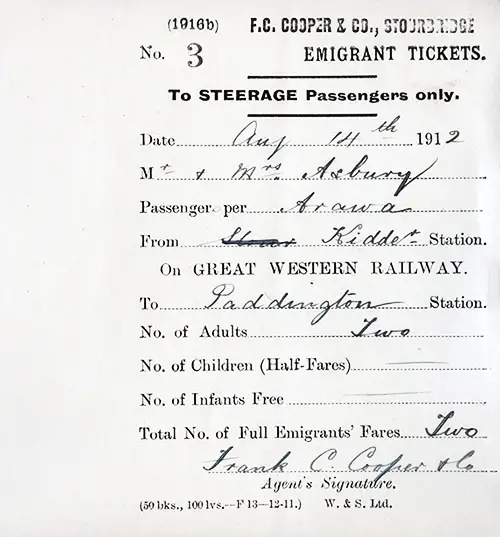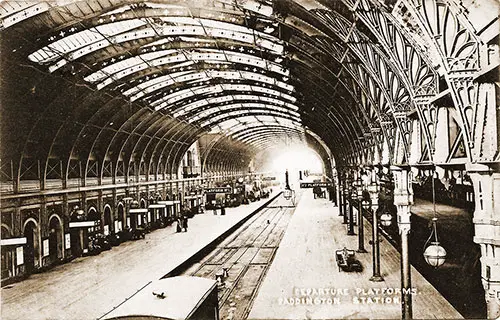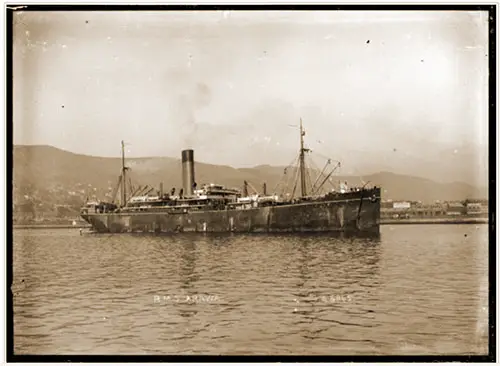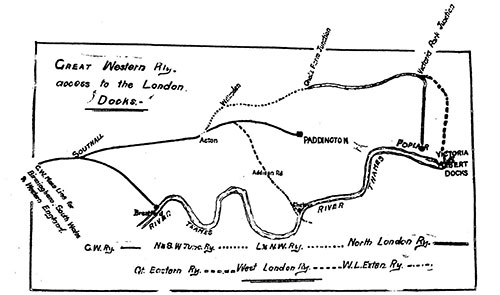Great Western Railway Emigrant Ticket - 14 August 1912

Great Western Railway Emigrant Ticket - United Kingdom: Kidderminser to Paddington Station, 14 August 1912. GGA Image ID # 1fa12eedf4
Summary of Railway Ticket
- Date of Purchase / Voyage: 14 August 1912
- Steamship Line: Great Western Railway
- Steamship: N/A
- Route: Kidderminster to Paddington Station in London
- Ticket Type: Railway Ticket
- Voyage Class: Steerage
- Name on Contract: Mr. & Mrs. Asbury
- Etnicity of Passenger(s): New Zealanders
- Contract Terms: Not Stated
- Cost of Ticket: Not Stated
Details of Railway Ticket
Very rare receipt for Emigrant Tickets purchased for travel on the Great Western Railway from F. C. Cooper & Co., Stourbridge, for Steerage Passengers Mr. & Mrs. Asbury from Kidderminster to Paddington Station in London to board the RMS Arawa bound for New Zealand.
Receipt Information
(1916b) F.C. COOPER & CO., STOURBRIDGE
No. 3 EMIGRANT TICKETS.
To STEERAGE Passengers Only
Date: August 14th 1912
Mr. & Mrs. Asbury
Passenger per Arawa
From Kiddeminster Station
On GREAT WESTERN RAILWAY
To Paddington Station
No. of Adults: Two
No. of Children (Half-Fares): ---
No. of Infants Free: ---
Total No. of Full Emigrants' Fares: Two
Agent's Signature: /s/ Frank C. Cooper & Co
(50 bks., 100 lvs. -- F13 -- 12-11.) W. & S. Ltd.
KIDDERMINSTER
A manufacturing town watered by the river Stour, and a market town of considerable importance. Kildderminster is celebrated for its carpet and cloth industry.
PADDINGTON STATION

Great Western Railway Departure Platforms at Paddington Station, 1904. GGA Image ID # 1fa232e8a4
The London terminus of the Great Western Railway is one of the finest railway stations in London—the aristocrat among the railway termini of the Metropolis.
It is the London gate to Windsor Castle, through which all the crowned heads of Europe have passed in turn, and it is the gateway out of London to the beautiful West of England, and to many another famous holiday haunt.
The station was designed by the great engineer, Isidore Kingdom Brunei, and was completed in 1854. The famous picture by Frith entitled "The Railway Station" is a faithful representation of the station as it appeared shortly after that time. The station has, of course, been considerably enlarged from time to time, and now occupies an area of no less than seventy acres.
Many are the conveniences for passengers which may be found at Paddington—an Inquiry Bureau is installed in the Main Booking Hall, at which all difficulties concerning trains and connections to any part may be adjusted, and all inquiries upon the subject of home travel satisfactorily answered.
Refreshments of the best character may be obtained at the Refreshment and Dining Rooms upon the departure side, the catering being under the direct control of the G.W.R. Hotels Management.
Newspapers and periodicals of all kinds, as well as the best class works of fiction, etc., may be obtained at the bookstalls upon the different platforms, and a circulating library is attached to the Main Bookstall upon No. i Platform.
The smoker will find abundant supplies of the best brands of the fragrant weed at the kiosk situated upon the same platform. Public telephones are installed in various parts of the building for the use of passengers, and telegrams may be forwarded from the Telegraph Office.
A post office box (having frequent clearances) will be found on the departure platform near the main booking hall, and a late-fee box, at which letters bearing the extra fee may be posted for many parts of the country up to a late hour, will also be found at the same place.
Insurances may be taken out at the Booking Office in connection with the purchase of tickets, and French or German money can be exchanged for English coin at the usual rates of exchange at the same office.
Passengers may find the number of the platform from which their trains start, at a glance, by reference to the notice boards in all parts of the station, and waiting friends are easily informed as to the time and platform at which trains will arrive by a reference to the special bulletin board situated between the arrival platforms, Nos. 8 and 9.
It is an easy matter to get to any part of London from Paddington Station; apart from the fleets of cabs, hansoms and hotel conveyances which may be found alongside the arrival platforms, and taxi-cabs which may be hired at the departure platform, 'buses run from the station to all parts.
There are covered ways to Praed Street Station (subway) and to Bishops Road Station (overhead way) both on the Underground Railway, and a few minutes' walk (through Spring Street) brings one to the Tube Station of the "Underground" at Lancaster Gate, Hyde Park.
A large number of first-class hotels and private boarding establishments may be found within easy reach of Paddington, and the Station is but a few minutes' walk from two of the most noted pleasances of London, namely Hyde Park and Kensington Gardens.
"KIDDERMINSTER" and "PADDINGTON STATION" in The Great Western Railway Official Guide, 1909: Holiday Haunts – England and Wales, Southern Ireland, and Brittany, Great Western Railway, Publishers, © 1909, p. 27-28, 438
RMS Arawa

The Steamship RMS Arawa, photographed by David James Aldersley between 1907-1928. Location unidentified. Photographer's title on negative - bottom center: RMS Arawa ©A 5845. Glass Negative. Ref: 1/2-012137-G. Alexander Turnbull Library, Wellington, New Zealand. /records/22692599.
THE GREAT WESTERN RAILWAY.
The widely radiating lines forming the Great Western system, having London as the point of con vergence, are put in touch with the traffic to and from the Port of London by two direct channels, viz., firstly, the railway route over the North London Rail way direct to the Poplar and East and West India Docks, and also off that railway on to the Great Eastern Railway for the Royal Albert Dock; and the London Tilbury and Southend line to Tilbury Docks.

The second access is the Thames tideway, which is linked to the railway by docks at Brentford and Chelsea, at both of which places traffic is transshipped to and from the Thames barges. It should be borne •in mind in this connection that London is known as a " barge port," and it is said that something like 80 per cent, of the total traffic dealt with at the docks, quays, wharves, and moorings of the Port is conveyed in barges to or away from the sea-going vessels.
THE NORTH LONDON RAILWAY ROUTE. :
Both routes are shown on the accompanying diagram. It will be seen that traffic over the railway for the North London route leaves or gains the great Western main line by the Acton Wells Junction, near Acton Station; and runs over the North and South-West Junction Railway between that junction and Willesden, and over the London and North-Western Railway between Willesden and Chalk Farm Junction; the North London Railway extending thence direct to Poplar Dock on the one hand, and to the junction with the Great Eastern Railway (Victoria Park Junction) for the Albert Dock and the Tilbury Docks (via the London Tilbury and Southend Railway) on the other.
TRAFFIC VIA THE RIVER THAMES.
The Great Western traffic passing along the navigable channel of the Thames travels over the Brentford branch line between Brentford Dock and the junction with the main line at Southall, the branch having been constructed many years ago with the object in view. Chelsea Dock is jointly held by the London and North-Western and Great Western Companies, and is in connection with the Great Western main line by means of the West London Railway from West London Junction to Addison Road; the West London Extension Railway (in which the Great Western and London and North-Western Companies are dominant partners) closing up the space from Addison Road to the dock. Actually, there is a subsidiary route, via the Regent's Canal, serving the Limehouse Dock, the traffic being exchanged between railway and canal adjoining Paddington Station.
WATERSIDE DOCKS AND DEPOTS OF THE GREAT WESTERN COMPANY.
Brentford Dock. —Extensive sidings and storage warehouses exist at the Brentford Dock, with ample craneage worked by hydraulic power, and capable of lifting loads up to 40 tons, for transshipment purposes; and a very large amount of traffic is dealt with in coal, manufactured goods in bulk for export, and general merchandise.
This dock affords a well- equipped, convenient and direct access per rail and barge between the Midlands and the East and West India, Victoria and Albert, St. Katharine's, London, Millwall, and Surrey Commercial Docks.
Chelsea Dock. —The basin here is conveniently situated for traffic between the Port and the West of London and suburban localities. At the depot, ample siding accommodation- is provided, as well as ware houses, cranes, stables, etc.
Poplar Dock. —The Great Western Company has a considerable establishment at the Poplar Dock of the North London Company, comprising a large area of sidings, and extensive warehouse accommodation, with hydraulic appliances, offices, and stabling for cartage purposes.
The Royal Albert Dock. —At this dock, the Great Western depot is of recent provision, and consists of a capacious warehouse and extensive siding room, cart roads, etc., the whole being well equipped with electrical hoisting appliances, and lighted by that agency.
Gaining the metropolis on its western side, the Great Western Railway is, in point of distance, the most. remote from the Port of all the railways reaching London.
The foregoing, however, will serve to show that it is no mean contributor to the railway facilities by which the activities of the Port are served. In formation is not to hand of the tonnage of sea-borne traffic of London passing over the system, but an inkling may perhaps be gained from the fact that something like 50,000 tons of merchandise are carried yearly to the Poplar Dock over the North London Railway, a figure which should perhaps be nearly doubled to cover return loads from the dock, being, moreover, exclusive of a heavy cartage traffic at that depot and of the traffic passing of the North London Railway to and from the Great Eastern line and the London Tilbury and Southend Railway.
As indicating the convenience of this route, it may be stated that the engines purchased a few years ago from a French firm for experimental purposes on the Great Western system, were landed at the Poplar Dock and carried via the North London line en-route to Swindon.
Summarizing the Great Western Railway and the London Docks
Summarizing the position of the Great Western Railway in relation to the London Docks, it will be seen that advantage is taken of means of access b, rail and by the river, and there is a material cartage traffic where this is more suitable.
All of which serves to denote the Company's endeavor to secure as much of the traffic as can be attracted to the system, the accommodation being sufficient, and up to modern requirements with that in view, so far as the particular circumstances of the railway and the conditions of metropolitan transport admit—the traffic offering by the North London Railway not having reached the maximum potentialities of that route, and the River Thames being a highway for traffic in illimitable quantity.
"London's Dock and Allied Railway Accommodation - No. VII: The Great Western Railway," in The Railway News: Rinance & Joint-Stock Companies' Journal, Vol 88, No. 2,271, Saturday, 13 July 1907, P. 72

